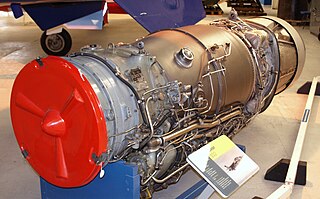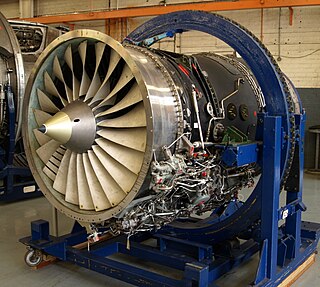
The turbofan or fanjet is a type of airbreathing jet engine that is widely used in aircraft propulsion. The word "turbofan" is a portmanteau of "turbine" and "fan": the turbo portion refers to a gas turbine engine which achieves mechanical energy from combustion, and the fan, a ducted fan that uses the mechanical energy from the gas turbine to force air rearwards. Thus, whereas all the air taken in by a turbojet passes through the combustion chamber and turbines, in a turbofan some of that air bypasses these components. A turbofan thus can be thought of as a turbojet being used to drive a ducted fan, with both of these contributing to the thrust.

The Rolls-Royce RB211 is a British family of high-bypass turbofan engines made by Rolls-Royce. The engines are capable of generating 41,030 to 59,450 lbf of thrust. The RB211 engine was the first production three-spool engine, and turned Rolls-Royce from a significant player in the aero-engine industry into a global leader.

The Rolls-Royce Trent is a family of high-bypass turbofans produced by Rolls-Royce. It continues the three spool architecture of the RB211 with a maximum thrust ranging from 61,900 to 97,000 lbf . Launched as the RB-211-524L in June 1988, the prototype first ran in August 1990. Its first variant is the Trent 700 introduced on the Airbus A330 in March 1995, then the Trent 800 for the Boeing 777 (1996), the Trent 500 for the A340 (2002), the Trent 900 for the A380 (2007), the Trent 1000 for the Boeing 787 (2011), the Trent XWB for the A350 (2015), and the Trent 7000 for the A330neo (2018). It has also marine and industrial variants like the RR MT30

The Pratt & Whitney PW2000, also known by the military designation F117 and initially referred to as the JT10D, is a series of high-bypass turbofan aircraft engines with a thrust range from 37,000 to 43,000 lbf. Built by Pratt & Whitney, they were designed for the Boeing 757. As a 757 powerplant, these engines compete with the Rolls-Royce RB211.

The Rolls-Royce Turbomeca Adour is a two-shaft low bypass turbofan aircraft engine developed by Rolls-Royce Turbomeca Limited, a joint venture between Rolls-Royce (UK) and Turbomeca (France). The engine is named after the Adour, a river in south western France.

The Turbo-Union RB199 is a turbofan jet engine designed and built in the early 1970s by Turbo-Union, a joint venture between Rolls-Royce, MTU and Aeritalia. The only production application was the Panavia Tornado.

The Rolls-Royce RB.183 Tay is a medium-bypass turbofan engine, developed from the RB.183 Mk 555 Spey core and using a fan scaled directly from the Rolls-Royce RB.211-535E4 to produce versions with a bypass ratio of 3.1:1 or greater. The IP compressor and LP turbine were designed using technology from the RB.211 programme. The engine was first run in August 1984. The Tay 650 had a new HP turbine which incorporated new technology which had been proven with the RB.211-535E4. This engine also had a new combustor for improved durability. The Tay family is used on a number of airliners and larger business jets, including the Gulfstream IV family, Fokker 70 and Fokker 100, with a later version being used to re-engine Boeing 727-100s.

The Rolls-Royce Spey is a low-bypass turbofan engine originally designed and manufactured by Rolls-Royce that has been in widespread service for over 40 years. A co-development version of the Spey between Rolls-Royce and Allison in the 1960s is the Allison TF41.

The General Electric TF39 was a high-bypass turbofan engine that was developed to power the Lockheed C-5 Galaxy. The TF39 was the first high-power, high-bypass jet engine developed. The TF39 was further developed into the CF6 series of engines, and formed the basis of the LM2500 and LM6000 marine and industrial gas turbine. On September 7, 2017, the last active C-5A powered with TF39 engines made its final flight to Davis-Monthan Air Force Base for retirement. The TF39 was effectively retired, and all remaining active C-5 Galaxys are now powered by F138 engines.

The Rolls-Royce Trent 500 is a high-bypass turbofan produced by Rolls-Royce to power the larger A340-500/600 variants. It was selected in June 1997, first ran in May 1999, first flew in June 2000, and achieved certification on 15 December 2000. It entered service in July 2002 and 524 engines were delivered on-wing until the A340 production ended in 2011.

The Rolls-Royce Trent 800 is a high-bypass turbofan produced by Rolls-Royce plc, one of the engine options for the early Boeing 777 variants. Launched in September 1991, it first ran in September 1993, was granted EASA certification on 27 January 1995, and entered service in 1996. It reached a 40% market share, ahead of the competing PW4000 and GE90, and the last Trent 800-powered 777 was delivered in 2010. The Trent 800 has the Trent family three shaft architecture, with a 280 cm (110 in) fan. With a 6.4:1 bypass ratio and an overall pressure ratio reaching 40.7:1, it generates up to 413.4 kN of thrust.

The Rolls-Royce Trent 900 is a high-bypass turbofan produced by Rolls-Royce plc to power the Airbus A380, competing with the Engine Alliance GP7000. Initially proposed for the Boeing 747-500/600X in July 1996, this first application was later abandoned but it was offered for the A3XX, launched as the A380 in December 2000. It first ran on 18 March 2003, made its maiden flight on 17 May 2004 on an A340 testbed, and was certified by the EASA on 29 October 2004. Producing up to 374 kN (84,000 lbf), the Trent 900 has the three shaft architecture of the Rolls-Royce Trent family with a 2.95 m (116 in) fan. It has a 8.5-8.7:1 bypass ratio and a 37–39:1 overall pressure ratio.

The Allison TF41 is a low-bypass turbofan engine.

The Rolls-Royce RB.401 was a British two-spool business jet engine which Rolls-Royce started to develop in the mid-1970s as a replacement for the Viper. RB.401-06 prototype engines were already being manufactured when a decision to develop the higher thrust RB.401-07 was taken.

The General Electric YF120, internally designated as GE37, was a variable cycle afterburning turbofan engine designed by General Electric Aircraft Engines in the late 1980s and early 1990s for the United States Air Force's Advanced Tactical Fighter (ATF) program. It was designed to produce maximum thrust in the 35,000 lbf (156 kN) class. Prototype engines were installed in the two competing technology demonstrator aircraft, the Lockheed YF-22 and Northrop YF-23.

The Progress D-18T is a 51,500 lbf (229 kN) high-bypass turbofan that powers the Antonov An-124 Ruslan and An-225 large freighters.

The Rolls-Royce RB.141 Medway was a large low-bypass turbofan engine designed, manufactured and tested in prototype form by Rolls-Royce in the early-1960s. The project was cancelled due to changes in market requirements that also led to the development and production of the smaller but similar Rolls-Royce Spey, and the cancellation of the Armstrong Whitworth AW.681 military transport aircraft project.

The Rolls-Royce/MAN Turbo RB.193 is a vectored thrust turbofan engine designed and manufactured by Rolls-Royce and MAN Turbo in the mid-1960s. The engine test flew in its sole application, the VFW VAK 191B VTOL fighter aircraft but production did not follow after cancellation of the associated aircraft project.

The General Electric Passport is a turbofan developed by GE Aviation for large business jets. It was selected in 2010 to power the Bombardier Global 7500/8000, first run on June 24, 2013, and first flown in 2015. It was certified in April 2016 and powered the Global 7500 first flight on November 4, 2016, before its 2018 introduction. It produces 14,000 to 20,000 lbf of thrust, a range previously covered by the General Electric CF34. A smaller scaled CFM LEAP, it is a twin-spool axial engine with a 5.6:1 bypass ratio and a 45:1 overall pressure ratio and is noted for its large one-piece 52 in (130 cm) fan 18-blade titanium blisk.

The Rolls-Royce Trent 7000 is a high-bypass turbofan engine produced by Rolls-Royce, an iteration of the Trent family powering exclusively the Airbus A330neo. Announced on 14 July 2014, it first ran on 27 November 2015. It made its first flight on 19 October 2017 aboard on the A330neo. It received its EASA type certification on 20 July 2018 as a Trent 1000 variant. It was first delivered on 26 November, and was cleared for ETOPS 330 by 20 December. Compared to the A330's Trent 700, the 68,000–72,000 lbf (300–320 kN) engine doubles the bypass ratio to 10:1 and halves emitted noise. Pressure ratio is increased to 50:1, and it has a 112 in (280 cm) fan and a bleed air system. Fuel consumption is improved by 11%.




















